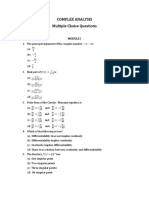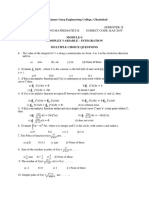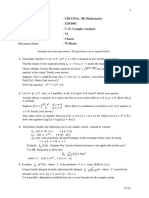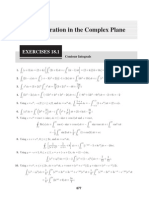Module 2
Uploaded by
Niramay KModule 2
Uploaded by
Niramay K1|Page
Syllabus:
Module-2: Complex Integration
2.1 Line Integral, Cauchy’s Integral theorem for simple connected and
multiply connected regions (without proof), Cauchy’s Integral formula
(Without proof).
2.2 Taylor’s and Laurent’s series (without proof).
2.3 Definition of Singularity, Zeroes, poles of f(z), Residues, Cauchy’s
Residue Theorem (without proof)
2.1
Line Integral
The line integral in complex plane is known as contour integral.
If a function of complex variable f(z) is continuous on a smooth curve C
parameterized by z(t) = x(t) + y(t)i on an interval [a, b], then the contour
integral of f(z) on C is given by
𝑏
∫ 𝑓(𝑧)𝑑𝑧 = ∫ 𝑓(𝑧(𝑡))𝑧 ′ (𝑡)𝑑𝑡
𝐶 𝑎
Type-1: Problems on Line Integral
A. Line Integral in cartesian form
Evaluate
1+𝑖 5 𝑖 5 𝑖
(1) ∫0 (𝑥 2 − 𝑖𝑦)𝑑𝑧 along the path (i) 𝑦 = 𝑥 (ii) 𝑦 = 𝑥 2 [Ans: (i) 6 − 6 (ii) 6 + 6 ]
2+𝑖
(2) ∫1−𝑖 𝑧 2 𝑑𝑧
(i) along the real axis from 0 to 3 and vertically to 3+i
(ii) along the imaginary axis from 0 to i and horizontally to 3+i
26
(iii) along the parabola 𝑥 = 3𝑦 2 [Ans: 6 + 𝑖 in each case]
3
2+𝑖
(3) ∫0 (𝑧̅)2 𝑑𝑧 along
(i) the line 2𝑦 = 𝑥
(ii) the real axis from 0 to 2 and then vertically to 2+i
(iii) the parabola 𝑥 = 2𝑦 2
10 5 14 11 8 41
[Ans: (i) − 3 𝑖 (ii) − 𝑖 (iii) 3 − 15 𝑖 ]
3 3 3
By Prof. Divesh Singh KJSIT , Sion
2|Page
4) ∫𝐶 (𝑦 − 𝑥 − 3𝑥 2 )𝑑𝑧 where C is a straight line from 𝑧 = 0 𝑡𝑜 𝑧 = 1 + 𝑖 [Ans: 1-i]
1+2𝑖 11 2
5) ∫0 (𝑧)2 𝑑𝑧 along the curve 𝑦 = 2𝑥 2 [Ans: − 3𝑖 ]
3
6) ∫𝐶 |𝑧|2 𝑑𝑧 where C is the boundary of square with vertices (0,0),(1,0),(1,1)
(0,1). [Ans: -1+i]
7) ∫𝐶 (𝑧 + 1)𝑑𝑧 where C is the boundary of square whose vertices are
𝑧 = 0, 𝑧 = 1, 𝑧 = 1 + 𝑖 , 𝑧 = 𝑖. [Ans: 0]
8) ∫𝐶 (𝑥 − 𝑖𝑦)𝑑𝑧 from (0,0) to (4,2) where C is first , the line segment joining
(0,0) to (0,2) and then the line segment joining (0,2) to (4,2) . [Ans: 10-8i]
9) ∫ 𝑓(𝑧)𝑑𝑧 along the square whose vertices are (1,1), (2,1), (2,2),(1,2) in anti-
clockwise direction where 𝑓(𝑧) = 𝑥 − 2𝑖𝑦 [Ans: 3i]
1+𝑖
10) ∫1−𝑖 (𝑖𝑥 + 𝑖𝑦 + 1)𝑑𝑥 along straight line joining (1-i) to (1+i) [Ans: 2(i-1)]
1+2𝑖
11) ∫0 (𝑧)2 𝑑𝑧 along
(i) the line 𝑥 = 2𝑦 .
(ii) the real axis from 𝑧 = 0 𝑡𝑜 𝑧 = 2 and then along the line parallel to the
imaginary axis from 𝑧 = 2 𝑡𝑜 𝑧 = 2 + 𝑖 .
(iii) the imaginary axis from 𝑧 = 0 𝑡𝑜 𝑧 = 1 and then along the line parallel to
the real axis from 𝑧 = 𝑖 𝑡𝑜 𝑧 = 2 + 𝑖 .
(iv) the parabola 𝑥 = 2𝑦 2
1
[Ans: 3 (2 + 11𝑖) in each case]
1+𝑖
12) ∫0 (𝑥 − 𝑦 + 𝑖𝑥 2 )𝑑𝑧
(i) along the line from 𝑧 = 0 𝑡𝑜 𝑧 = 1 + 𝑖 .
(ii) along the real axis from 𝑧 = 0 𝑡𝑜 𝑧 = 1 and then along the line parallel
to the imaginary axis from 𝑧 = 1 𝑡𝑜 𝑧 = 1 + 𝑖 .
(iii) along the imaginary axis from 𝑧 = 0 𝑡𝑜 𝑧 = 𝑖 and then along the line
parallel to the real axis from 𝑧 = 𝑖 𝑡𝑜 𝑧 = 1 + 𝑖 .
(iv) along the parabola 𝑦 2 = 𝑥
1 1 5 1 1 11 1
[(i) 3 (𝑖 − 1) (ii) − 2 + 6 𝑖 (iii) − 2 − 6 𝑖 (iv) − 30 + 6 𝑖]
1+𝑖
13) ∫0 (𝑧)2 𝑑𝑧 along (i) the line 𝑦 = 𝑥 (ii) the parabola 𝑦 2 = 𝑥
By Prof. Divesh Singh KJSIT , Sion
3|Page
2
Is the line integral independent of path? Explain. [Ans:3 (𝑖 − 1) in each case]
1+𝑖
14) ∫0 (𝑥 2 + 𝑖𝑦)𝑑𝑧 along the path (i) 𝑦 = 𝑥 (ii) 𝑥 2 = 𝑦 (iii) along the x-axis from 0
to 1 the along the line parallel to y-axis from 𝑧 = 1 𝑡𝑜 𝑧 = 1 + 𝑖.
Is the line integral independent of path? Explain.
−1+5𝑖 −1+5𝑖 −1
[Ans: i) (ii) (iii) +𝑖 ]
6 6 6
15) ∫ 𝑓(𝑧)𝑑𝑧 along the parabola 𝑦 = 2𝑥 2 from 𝑧 = 0 𝑡𝑜 𝑧 = 3 + 18𝑖 where
𝑓(𝑧) = 𝑥 2 − 2𝑖𝑦 [Ans: 333+45 i]
16) ∫ 𝑓(𝑧)𝑑𝑧 along the parabola 𝑦 = 2𝑥 2 from 𝑧 = 0 𝑡𝑜 𝑧 = 3 + 18𝑖 where
3933
𝑓(𝑧) = 𝑥 2 − 2𝑖𝑥𝑦 [Ans: ]
5
B. Line integral in parametric form
Evaluate
2+𝑖 25
17) ∫1−𝑖 (2𝑥 + 𝑖𝑦 + 1)𝑑𝑧 along the curve 𝑥 = 𝑡 + 1 , 𝑦 = 2𝑡 2 − 1 [Ans: 4 + 𝑖]
3
18) ∫𝐶 𝑧 𝑑𝑧 from 𝑧 = 0 𝑡𝑜 𝑧 = 1 + 𝑖 along the curve 𝑧 = 𝑡 2 + 𝑖𝑡 [Ans: i]
30−8𝑖
19) ∫ 𝑧̅ 𝑑𝑧 from 𝑧 = 0 𝑡𝑜 𝑧 = 4 + 2𝑖 along the curve 𝑧 = 𝑡 2 + 𝑖𝑡 [Ans: ]
3
C. Line integral in Polar form
Evaluate
𝑑𝑧
20) ∫𝐶 , where C is the circle |𝑧| = 𝑟 in the positive sense [Ans:2𝜋𝑖]
𝑧
2
21) Evaluate ∫𝐶 (𝑧 − 𝑧 2 ) 𝑑𝑧 along the upper half of the circle |𝑧| = 1 [Ans:3]
𝑧+2
22) ∫𝐶 𝑑𝑧 , where C is the semi-circle 𝑧 = 2𝑒 𝑖𝜃 , 0 ≤ 𝜃 ≤ 𝜋 [Ans:−4 + 2𝜋𝑖]
𝑧
23) ∫ 𝑧̅ 𝑑𝑧 where C is the upper half of the circle 𝑟 = 1 [Ans: 𝑖𝜋]
24) ∫𝐶 (𝑧̅ + 2𝑧) 𝑑𝑧 along the circle 𝑥 2 + 𝑦 2 = 1 [Ans: 2𝜋𝑖 + 𝑒 4𝑖𝜋 − 1]
2𝑧+3
25) ∫𝐶 𝑑𝑧 where C is
𝑧
(i) the upper half of the circle |𝑧| = 2
(ii) the lower half of the circle |𝑧| = 2
(iii) the whole circle in anti-clockwise direction.
[Ans: (i) 2(3𝜋𝑖 − 4) (ii) 2(4 − 3𝜋𝑖) (iii) 12]
By Prof. Divesh Singh KJSIT , Sion
4|Page
26) ∫𝐶 (𝑧 − 𝑧 2 ) 𝑑𝑧 where C is the upper half of the circle |𝑧| = 1 . What is the value
2 2
of the integral for the lower half of the same circle. [Ans: , − 3]
3
27) Show that ∫𝐶 log(𝑧) 𝑑𝑧 = 2𝜋𝑖 , where C is the unit circle in the z-plane.
Type-II: Problems on Cauchy Integral Theorem and Cauchy Integral formula
Evaluate
1. ∫𝐶 (𝑥 2 − 𝑦 2 + 2𝑖𝑥𝑦)𝑑𝑧 , where C is the circle |𝑧| = 2 [Ans: 0]
1 1
2. ∫𝐶 cot 𝑧 𝑑𝑧 where C is |𝑧 + 2| = 3 . [Ans: 0]
𝑧+3
3. ∫𝐶 𝑑𝑧 where C is the circle |𝑧 − 1| = 1 . [Ans: 0]
𝑧 2 −2𝑧+5
1
4. ∫𝐶 tan 𝑧 𝑑𝑧 , where C is |𝑧| = 2 [Ans: 0]
5. ∫𝐶 cosec 𝑧 𝑑𝑧 , where C is |𝑧| = 1 [Ans:2𝜋𝑖]
𝑑𝑧
6. ∫𝐶 where C is the circle 𝑥 2 + 𝑦 2 = 16 [Ans:2𝜋𝑖]
sinh 𝑧
sin 3𝑧
7. ∫𝐶 𝜋 𝑑𝑧 where C is the circle |𝑧| = 5 [Ans:2𝜋𝑖]
𝑧+
2
𝑑𝑧
8. ∫𝐶 where C is the circle (i) |𝑧 − 2| = 1 (ii) |𝑧 − 1| = 1/2
𝑧−2
[𝐴𝑛𝑠: (𝑖)2𝜋𝑖 (𝑖𝑖) 0 ]
𝑒𝑧
9. ∫𝐶 𝑑𝑧 where C is the circle (i) |𝑧| = 2 (ii) |𝑧| = 1/2 [Ans:(i) 2𝜋𝑖𝑒 2 (ii)0 ]
𝑧−1
𝑠𝑖𝑛6 𝑧
10. ∫𝐶 𝜋 𝑛
𝑑𝑧 where C is the circle |𝑧| = 1 for n=1 and n=3
(𝑧− )
6
𝜋𝑖 21𝜋𝑖
[ Ans: , ]
32 16
1 𝜋𝑖
11. ∫𝐶 𝑑𝑧 where C is the circle |𝑧| = 1 [Ans:− 3 ]
𝑧4𝑒𝑧
𝑧𝑒 𝑧
12. ∫𝐶 (𝑧−1)3
𝑑𝑧 where C is the circle |𝑧 + 𝑖| = 2 [Ans:8𝜋𝑖𝑒 2 ]
cos(𝜋𝑧 2 )
13. ∫𝐶 (𝑧 2 −3𝑧+2)
𝑑𝑧 where C is the circle |𝑧| = 3 [Ans:4𝜋𝑖]
sin(𝜋𝑧 2 )+cos(𝜋𝑧 2 )
14. ∫𝐶 (𝑧 2 −3𝑧+2)
𝑑𝑧 where C is the circle |𝑧| = 3 [Ans:4𝜋𝑖]
𝑧+6
15. ∫𝐶 𝑑𝑧 where C is the circle (i) |𝑧| = 1 (ii) |𝑧 − 2| = 1 (iii) |𝑧 + 2| = 1
𝑧 2 −4
[𝐴𝑛𝑠: (𝑖)0 (𝑖𝑖)4𝜋𝑖 (𝑖𝑖𝑖) − 2𝜋𝑖 ]
𝑧−1 2𝜋𝑖
16. ∫𝐶 (𝑧−1)2 (𝑧−2)
𝑑𝑧 where C is the circle |𝑧 − 𝑖| = 2 [Ans:− ]
9
By Prof. Divesh Singh KJSIT , Sion
5|Page
sin(𝜋𝑧 2 )+cos(𝜋𝑧 2 ) 1 3
17. ∫𝐶 (𝑧 2 +3𝑧+2)
𝑑𝑧 where C is the circle (𝑖) |𝑧| = 2 (𝑖𝑖)|𝑧| = 2
[Ans:(𝑖) 0 (𝑖𝑖) − 2𝜋𝑖]
𝑒 2𝑧 8𝜋𝑖𝑒 2
18. ∫𝐶 (𝑧−1)4
𝑑𝑧 where C is the circle |𝑧| = 2 [Ans: ]
3
𝑧𝑒 2𝑧
19. ∫𝐶 (𝑧−1)3
𝑑𝑧 where C is the circle |𝑧 + 𝑖| = 2 [Ans:8𝜋𝑖𝑒 2 ]
𝑧 cos 𝜋𝑧 −2𝜋𝑖
20. ∫𝐶 𝑑𝑧 where C is the circle |𝑧 − 𝑖| = 2 [Ans: ]
𝑧 2 −𝑧−2 3
(𝑧−1)(𝑧−2)
21. ∫𝐶 𝑑𝑧 where C is the circle (𝑖)|𝑧| = 3.5 (𝑖𝑖)|𝑧| = 4.5
(𝑧−3)(𝑧−4)
[Ans:(𝑖) − 4𝜋𝑖 (ii) 8𝜋𝑖]
𝑧+1 −3𝜋𝑖
22. ∫𝐶 𝑑𝑧 where C is the circle |𝑧| = 1 [Ans: ]
𝑧 3 −2𝑧 2
𝑧 2 +4
23. ∫𝐶 𝑑𝑧 where C is the circle (𝑖)|𝑧 + 1| = 2 (𝑖𝑖)|𝑧 − 2| = 2
(𝑧−2)(𝑧+3𝑖)
16𝜋𝑖
[Ans:(𝑖)0 (ii) ]
(2+3𝑖)
(𝑧+4)2 −16𝜋𝑖
24. ∫𝐶 𝑑𝑧 where C is the circle |𝑧| = 1 [Ans: ]
𝑧 4 +5𝑧 3 +6𝑧 2 9
𝑧+3 14𝜋𝑖
25. ∫𝐶 𝑑𝑧 where C is the circle |𝑧 − 𝑖| = 2 [Ans: ]
2𝑧 2 +3𝑧−2 5
𝑧+2
26. ∫𝐶 𝑑𝑧 where C is the circle |𝑧 − 2 − 𝑖| = 2 [Ans:2𝜋𝑖]
𝑧 3 −2𝑧 2
𝑧2 1
27. ∫𝐶 𝑑𝑧 where C is the circle (𝑖)|𝑧| = 2 (𝑖𝑖)|𝑧 − 1| = 1(𝑖𝑖𝑖)|𝑧 + 𝑖| = 1
𝑧 4 −1
𝜋𝑖 𝜋
[Ans:(𝑖)0 (ii) (iii)− 2 ]
2
4𝑧 2 +𝑧+5
28. 𝑓(𝜉) = ∫𝐶 𝑑𝑧 where C is the ellipse , find the values of
𝑧−𝜉
𝑓(𝑖), 𝑓 ′ (−1) , 𝑓 ′′ (−𝑖) 𝑎𝑛𝑑 𝑓(3) . [Ans:(𝑖)2𝜋𝑖(1 + 𝑖) (ii)−14𝜋𝑖 (iii)16𝜋𝑖(𝑖𝑣)0 ]
𝑧𝑒 𝑧
29. If Φ(𝛼) = ∫𝐶 𝑑𝑧 , where C is |𝑧 − 2𝑖| = 3 , find the value of
𝑧−𝛼
(𝑖)Φ(1) (𝑖𝑖)Φ′ (2) (𝑖𝑖𝑖)Φ(3) [Ans:(𝑖)2𝜋𝑖𝑒 (ii)6𝜋𝑖𝑒 2 (iii)0 ]
3𝑧 2 +7𝑧+1
30. 𝑓(𝜉) = ∫𝐶 𝑑𝑧 where C is the circle |𝑧| = 2, find the values of
𝑧−𝜉
𝑓(−3), 𝑓(𝑖), 𝑓 ′ (1 − 𝑖) , 𝑓 ′′ (1 − 𝑖).[Ans:(𝑖)0 (ii)−2𝜋(7 + 2𝑖)(iii)2𝜋(6 + 13𝑖)(𝑖𝑣)12𝜋𝑖 ]
By Prof. Divesh Singh KJSIT , Sion
6|Page
Type-III Taylor’s and Laurent’s Series expansion
1. Find the radius of convergence of the following series
2
1 1 𝑛 𝑛+3 𝑛 1
(i) ∑ 𝑧𝑛 (ii) ∑ (1 − 𝑛) 𝑧 𝑛 (iii) ∑ 𝑧 (iv) ∑ 2𝑛 +1 𝑧 𝑛
𝑛𝑝 3𝑛
2
𝑛+1 1 𝑛
(v) ∑ (𝑛+2)(𝑛+3) 𝑧 𝑛 (vi) ∑ (1 + 𝑛) 𝑧𝑛
[Ans: (i) 1 (ii) e (iii) 3 (iv) 2 (v) 1 (vi) 1/e ]
𝜋
2. Expand 𝑓(𝑧) = sin 𝑧 as a Taylor’s series around 𝑧 = 4
𝜋
3. Expand 𝑓(𝑧) = cos 𝑧 as a Taylor’s series around 𝑧 = 2
sin 𝑧
4. Expand 𝑓(𝑧) = as a Taylor’s series around 𝑧 = 𝜋 .
𝑧−𝜋
𝜋
5. Expand 𝑓(𝑧) = cos 𝑧 as a Taylor’s series around 𝑧 = 3
1
6. Expand 𝑓(𝑧) = 𝑧 2 +4as a Taylor’s series around 𝑧 = −𝑖 .
1
7. Expand 𝑓(𝑧) = (𝑧−1)(𝑧−3)as a Taylor’s series around 𝑧 = 4 .
8. Find all possible Laurent’s series expansion of the following functions
indicating region of convergence.
4−3𝑧
(i) about 𝑧 = 0
𝑧(1−𝑧)(2−𝑧)
𝑧 2 −1
(ii) about 𝑧 = 0
𝑧 2 +5𝑧+6
𝑧
(iii) about 𝑧 = −2
(𝑧−1)(𝑧−2)
𝑧 3 −6𝑧−1
(iv) about 𝑧 = 3
(𝑧−1)(𝑧+2)(𝑧−3)
(𝑧−2)(𝑧+2)
(v) about 𝑧 = 0
(𝑧+1)(𝑧+4)
𝑧−1
9. Obtain Taylor’s and Laurent’s expansion of indicating regions
𝑧 2 −2𝑧−3
of convergence.
1
10. Obtain Taylor’s and Laurent’s expansion of indicating
𝑧 2 (𝑧−1)(𝑧+2)
regions of convergence.
𝑧 2 −1
11. Expand about 𝑧 = 0
𝑧 2 +5𝑧+6
7𝑧−2
12. Obtain Taylor’s and Laurent’s expansion of about
𝑧(𝑧−2)(𝑧+1)
z=-1 .
1
13. Obtain Taylor’s and Laurent’s expansion of (𝑧+2)(𝑧 2 +1)
2𝑧−3
14. Obtain Taylor’s and Laurent’s expansion of indicating
𝑧 2 −4𝑧−3
regions of convergence in the powers of (𝑧 − 4).
3𝑧−3
15. Expand 𝑓(𝑧) = (2𝑧−1)(𝑧−2) in a Laurent’s series about 𝑧 = 1
1
convergent in < |𝑧 − 1| < 1 .
2
By Prof. Divesh Singh KJSIT , Sion
7|Page
Type-IV
Types of Singularity
When f(z) is regular on a punctured neighbourhood
D \ {a} = {z ∈ ℂ: 0 < |z − a| < r} of a point a but is not defined at a, we call a
a singularity of f(z). More precisely, we say that a is
1. a removable singularity of f(z) if there are no terms in the principal part
of its Laurent expansion about a.
2. a pole of f(z) if there are finitely many terms (but not none!) in the
principal part of its Laurent expansion about a.
3. an nonisolated essential singularity of f(z) if there are infinitely many
(non-zero) terms in the principal part of its Laurent expansion about a.
4. Furthermore, in case 2 we say that a is a pole of order n of f(z) if the
1
largest power of present in the expansion is the nth power.
𝑧−𝒂
5. Poles of order 1, 2 and 3 are often referred to as simple poles, double
poles, and triple poles. (Terms such as quadruple and quintuple will also
occasionally be encountered.)
1 −1
1. State the nature of singularity of 𝑓(𝑧) = [𝑠𝑖𝑛 (𝑧)]
𝜋 −1
2. State the nature of singularity of 𝑓(𝑧) = [𝑠𝑖𝑛 ( 𝑧 )]
𝑧−2 1
3. State the nature of singularity of 𝑓(𝑧) = 𝑠𝑖𝑛 (𝑧−1)
𝑧2
sin 𝑧
4. State the nature of singularity of 𝑓(𝑧) = 𝑧
2
5. State the nature of singularity of 𝑓(𝑧) = 𝑒 −1/𝑧
6. Determine the nature of pole of following functions and find the residue at
each pole.
𝑧𝑒 𝑧 1−𝑒 2𝑧 2 sin 𝜋𝑧
(i) (𝑧−𝑎)3
(ii) (iii) 𝑧 2 𝑒 1/𝑧 (iv) 𝑒 −1/(𝑧−1) (v) .
𝑧3 (𝑧−1)2 (𝑧−2)
7. Using Cauchy’s residue theorem evaluate the following
2
(i) ∮𝐶 𝑒 1/𝑧 𝑑𝑧 where C is the circle |𝑧| = 1 [Ans: 0]
sin 𝑧 𝜋𝑖
(ii) ∮𝐶 𝑑𝑧 where C is the circle |𝑧| = 1 [Ans: ]
𝑧6 60
𝜋𝑖
(iii) ∮𝐶 𝑧 4 𝑒 1/𝑧 𝑑𝑧 where C is the circle |𝑧| = 1 [Ans: ]
60
15𝑧+9
8. ∫𝐶 𝑑𝑧 where C is the circle |𝑧 − 1| = 3 [Ans: 4𝜋𝑖]
𝑧 3 −9𝑧
By Prof. Divesh Singh KJSIT , Sion
8|Page
12𝑧−7
9. ∫𝐶 (𝑧−1)2 (2𝑧+3)
where C is the circle |𝑧 + 𝑖| = √3 [Ans: 4𝜋𝑖]
sin 3𝑧
10. ∫𝐶 𝜋 𝑑𝑧 where C is the circle |𝑧| = 5 [Ans:2𝜋𝑖]
𝑧+
2
𝑑𝑧
11. ∫𝐶 where C is the circle (i) |𝑧 − 2| = 1 (ii) |𝑧 − 1| = 1/2
𝑧−2
[𝐴𝑛𝑠: (𝑖)2𝜋𝑖 (𝑖𝑖) 0 ]
𝑒𝑧
12. ∫𝐶 𝑑𝑧 where C is the circle (i) |𝑧| = 2 (ii) |𝑧| = 1/2 [Ans:(i) 2𝜋𝑖𝑒 2
𝑧−1
(ii)0 ]
𝑠𝑖𝑛6 𝑧
10. ∫𝐶 𝜋 𝑛
𝑑𝑧 where C is the circle |𝑧| = 1 for n=1 and n=3
(𝑧− )
6
𝜋𝑖 21𝜋𝑖
[ Ans: , ]
32 16
1 𝜋𝑖
11. ∫𝐶 𝑑𝑧 where C is the circle |𝑧| = 1 [Ans:− 3 ]
𝑧4𝑒𝑧
𝑧𝑒 𝑧
12. ∫𝐶 (𝑧−1)3
𝑑𝑧 where C is the circle |𝑧 + 𝑖| = 2 [Ans:8𝜋𝑖𝑒 2 ]
cos(𝜋𝑧 2 )
13. ∫𝐶 (𝑧 2 −3𝑧+2)
𝑑𝑧 where C is the circle |𝑧| = 3 [Ans:4𝜋𝑖]
sin(𝜋𝑧 2 )+cos(𝜋𝑧 2 )
14. ∫𝐶 (𝑧 2 −3𝑧+2)
𝑑𝑧 where C is the circle |𝑧| = 3 [Ans:4𝜋𝑖]
𝑧+6
15. ∫𝐶 𝑑𝑧 where C is the circle (i) |𝑧| = 1 (ii) |𝑧 − 2| = 1 (iii) |𝑧 + 2| = 1
𝑧 2 −4
[𝐴𝑛𝑠: (𝑖)0 (𝑖𝑖)4𝜋𝑖 (𝑖𝑖𝑖) − 2𝜋𝑖 ]
𝑧−1 2𝜋𝑖
16. ∫𝐶 (𝑧−1)2 (𝑧−2)
𝑑𝑧 where C is the circle |𝑧 − 𝑖| = 2 [Ans:− ]
9
sin(𝜋𝑧 2 )+cos(𝜋𝑧 2 ) 1 3
17. ∫𝐶 (𝑧 2 +3𝑧+2)
𝑑𝑧 where C is the circle (𝑖) |𝑧| = 2 (𝑖𝑖)|𝑧| = 2
[Ans:(𝑖) 0 (𝑖𝑖) − 2𝜋𝑖]
𝑒 2𝑧 8𝜋𝑖𝑒 2
18. ∫𝐶 (𝑧−1)4
𝑑𝑧 where C is the circle |𝑧| = 2 [Ans: ]
3
𝑧𝑒 2𝑧
19. ∫𝐶 (𝑧−1)3
𝑑𝑧 where C is the circle |𝑧 + 𝑖| = 2 [Ans:8𝜋𝑖𝑒 2 ]
𝑧 cos 𝜋𝑧 −2𝜋𝑖
20. ∫𝐶 𝑑𝑧 where C is the circle |𝑧 − 𝑖| = 2 [Ans: ]
𝑧 2 −𝑧−2 3
(𝑧−1)(𝑧−2)
21. ∫𝐶 𝑑𝑧 where C is the circle (𝑖)|𝑧| = 3.5 (𝑖𝑖)|𝑧| = 4.5
(𝑧−3)(𝑧−4)
[Ans:(𝑖) − 4𝜋𝑖 (ii) 8𝜋𝑖]
𝑧+1 −3𝜋𝑖
22. ∫𝐶 𝑑𝑧 where C is the circle |𝑧| = 1 [Ans: ]
𝑧 3 −2𝑧 2
By Prof. Divesh Singh KJSIT , Sion
9|Page
𝑧 2 +4
23. ∫𝐶 𝑑𝑧 where C is the circle (𝑖)|𝑧 + 1| = 2 (𝑖𝑖)|𝑧 − 2| = 2
(𝑧−2)(𝑧+3𝑖)
16𝜋𝑖
[Ans:(𝑖)0 (ii) ]
(2+3𝑖)
(𝑧+4)2 −16𝜋𝑖
24. ∫𝐶 𝑑𝑧 where C is the circle |𝑧| = 1 [Ans: ]
𝑧 4 +5𝑧 3 +6𝑧 2 9
𝑧+3 14𝜋𝑖
25. ∫𝐶 𝑑𝑧 where C is the circle |𝑧 − 𝑖| = 2 [Ans: ]
2𝑧 2 +3𝑧−2 5
𝑧+2
26. ∫𝐶 𝑑𝑧 where C is the circle |𝑧 − 2 − 𝑖| = 2 [Ans:2𝜋𝑖]
𝑧 3 −2𝑧 2
𝑧2 1
27. ∫𝐶 𝑑𝑧 where C is the circle (𝑖)|𝑧| = 2 (𝑖𝑖)|𝑧 − 1| = 1(𝑖𝑖𝑖)|𝑧 + 𝑖| = 1
𝑧 4 −1
𝜋𝑖 𝜋
[Ans:(𝑖)0 (ii) (iii)− 2 ]
2
By Prof. Divesh Singh KJSIT , Sion
You might also like
- Unit-Iii - Complex Integration: F (Z) DZ 0No ratings yetUnit-Iii - Complex Integration: F (Z) DZ 020 pages
- The Problems Marked (T) Need An Explicit Discussion in The Tutorial Class. Other Problems Are For Enhanced Practice. 1. (A) ZZDZNo ratings yetThe Problems Marked (T) Need An Explicit Discussion in The Tutorial Class. Other Problems Are For Enhanced Practice. 1. (A) ZZDZ6 pages
- Complex Variables: Question and AnswereNo ratings yetComplex Variables: Question and Answere15 pages
- 2010 - Assignment On Complex Variables - 12No ratings yet2010 - Assignment On Complex Variables - 122 pages
- ACFrOgAgAS9KaTSZ3TKzHDgBpsDpDGZXd0mx1Wt48x6qGAgh-wK6UBRMcGAxTcFwwO4vqQn2sAg2FqKRA4xiSw2GnIovVi5SOBMyrKPckOYhW-ASKIhNWOcahqTLgmBARKKo0ZV8B9rRTcVSx_yM5rESpvmuoQ3H5Zu-Bo_rVSGS5NO11grGfE5_gZ9PBexghlMav4Lh7No ratings yetACFrOgAgAS9KaTSZ3TKzHDgBpsDpDGZXd0mx1Wt48x6qGAgh-wK6UBRMcGAxTcFwwO4vqQn2sAg2FqKRA4xiSw2GnIovVi5SOBMyrKPckOYhW-ASKIhNWOcahqTLgmBARKKo0ZV8B9rRTcVSx_yM5rESpvmuoQ3H5Zu-Bo_rVSGS5NO11grGfE5_gZ9PBexghlMav4Lh75 pages
- EMT 2201 ENGINEERING MATHS IV ASSIGNMENT - 1No ratings yetEMT 2201 ENGINEERING MATHS IV ASSIGNMENT - 13 pages
- Functions of A Complex Variable (S1) Problem Sheet 3: University of Oxford Trinity Term 2012No ratings yetFunctions of A Complex Variable (S1) Problem Sheet 3: University of Oxford Trinity Term 20124 pages
- St. Joseph'S College of Engineering, Chennai Ma1202 - Engineering Mathematics - Ii Class NotesNo ratings yetSt. Joseph'S College of Engineering, Chennai Ma1202 - Engineering Mathematics - Ii Class Notes33 pages
- 3140610_CVPDE_GTU_Study_Material_e-Notes_Unit---3_30012021064218AMNo ratings yet3140610_CVPDE_GTU_Study_Material_e-Notes_Unit---3_30012021064218AM11 pages
- Integration in The Complex Plane: Exercises 18.1No ratings yetIntegration in The Complex Plane: Exercises 18.119 pages
- UPSC Previous Year Complex Analysis Question Paper Mathematics OptionalNo ratings yetUPSC Previous Year Complex Analysis Question Paper Mathematics Optional10 pages
- Solutions for Math 311 Final: i (π/3+i) −i (π/3+i)No ratings yetSolutions for Math 311 Final: i (π/3+i) −i (π/3+i)10 pages
- Problems For MATH-4300 Complex VariablesNo ratings yetProblems For MATH-4300 Complex Variables25 pages






























































